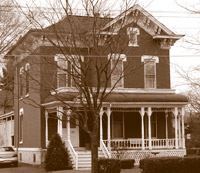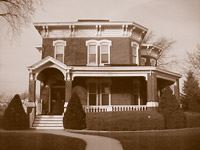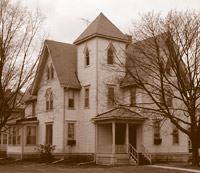This pleasant tour will take you by more of Aurora's architecturally significant homes. An important part of Aurora's history, many of the early residents included prominent Aurora businessmen, such as Reuben Hobbs, a founder of the Aurora Cotton Mills.
W.E.N. Hunter and Company of Detroit designed this late Gothic Revival style church in 1929. Characteristic features include the arched windows, tracery, and rose window. The rose or chancel window is the focal point of the church. When daylight shines through the window, the colorful stained glass is illuminated. At night, interior lighting reveals the gold leaf on the lead that surrounds the stained glass, resulting in a completely different effect.
Location: Corner of Galena Boulevard and May Street, Aurora, IL 60505
William P. Nicholson had this Queen Anne style house built between 1890 and 1892. Note how clapboards are applied vertically and diagonally for decorative effect. Nicholson worked as a chemical examiner for the Chicago and Aurora Smelting Company.
Location: 550 Galena Boulevard, Aurora, IL 60505

This late Gothic Revival-style apartment house with pointed arched doors was built in 1928 by R.M. and L.E. Baldwin. It features pointed arched doors with Tudor style hood details, stone trim and battlements. Its courtyard design provides light and air to the apartments.

J.E. Minott designed this Italianate style house in 1884. The unusual convex mansard roofed porch and side porch are elegant features. Judson and L.F. Arnold platted Oswego in 1835. Judson moved to Aurora and was an organizer of Aurora Silver Plate.
Location: 460 W. Galena Boulevard, Aurora, IL 60505
Lewis Judson also had this Queen Anne style duplex built from 1887 to 1895. The window cornice hoods and medallions under the eaves are signs that Judson invested in making this an attractive addition to the neighborhood.

This elaborate Italianate style house was built from 1882 to 1884 for Frank Randall. A later owner, Reuben Hobbs, built the carriage house and was treasurer of the Aurora Cotton Mills. Note the limestone arch over the entrance and the paired brackets and panels under the eaves. The porch replaces the earlier entrance and side porches.
Location: 503 W. Galena Boulevard, Aurora, IL 60505
This school was designed by Patton and Miller of Chicago, and built from 1905 to 1906. Its facilities included a gymnasium, bike room, auditorium, classrooms and laboratories. The western additions date from 1925 and 1951.
Location: 14 Blackhawk Street, Aurora, IL 60505

Dr. Mowry spent over $8,000 to have this Gothic Revival style house built in 1886. The steeply pitched rooflines and arched windows give the house an ecclesiastical tone. Mowry had one of the region's largest surgical practices and was appointed U.S. Pension Examining Surgeon in 1887.
Location: 504 W. New York Street, Aurora, IL 60505
This Italianate style house was built for Hoyt between 1867 and 1870. He and his brother founded Hoyt Brothers, a major woodworking machinery company. The home was moved from the northwest corner of Galena and May Street when Wesley Church was built. The current front porch replaced a narrow entry porch.
Location: 552 W. New York Street, Aurora, IL 60505
Between 1890 and 1891, Reuben Hobbs built this house and sold it to Coster. Note the variety of shaped shingles in the gable and the rope edged moldings along the front bay's hipped roof.
Location: 110 N. May Street, Aurora, IL 60505
Oscar Tanner built this house circa 1894, with Wolf Dembner, a dry goods merchant as one of its earliest occupants. The second-floor flares out above the first floor, and is supported by quarter circle brackets.
Location: 116 N. May Street, Aurora, IL 60505
Tanner has this Queen Anne style house built in 1891. Note its projecting bays, second-floor overhand, and recessed porch.
Location: 120 N. May Street, Aurora, IL 60505
Two View Street residents, J.G. Ralph, a builder, and Everett Hall had this Queen Anne style house built circa 1892. Note the diagonal board trim between the front windows and the shaped gable shingles. One of its earliest occupants was Arthur V. Greenman, superintendent of the West Side Schools.